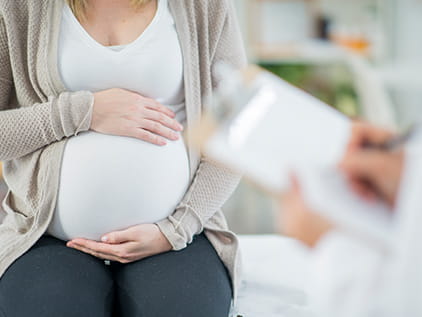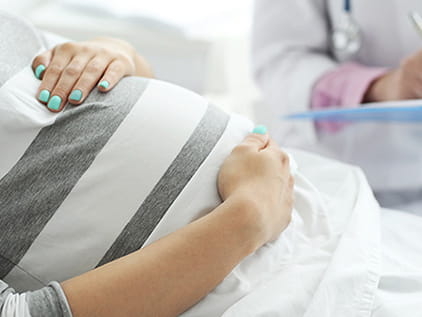Pregnancy Care
Quality pregnancy care is important for a happy and healthy pregnancy. During your pregnancy, regularly scheduled appointments with your doctor are important and necessary. It is vital to keep each prenatal appointment so that your physician can provide you with important information and monitor your pregnancy progress. In addition, this allows you an opportunity to discuss any concerns or questions you may have.
At The University of Kansas Health System, our team is here to help guide you through this wonderful and challenging time of life. That team includes OB-GYNs, maternal-fetal medicine specialists, midwives and family medicine providers. Thank you for entrusting us with your care and allowing us to be a part of this beautiful journey called parenthood.
What is pregnancy care?
At each prenatal visit, your weight, blood pressure and urine will be tested. Your physician will also measure your abdomen and discuss your pregnancy progress. The frequency of your visits may vary depending on any specific concerns. However, most will follow this schedule:
- Until 32 weeks of pregnancy, visits are scheduled approximately every 4 weeks.
- Between 32 weeks and 36 weeks, visits are scheduled approximately every 2 weeks.
- From 36 weeks to delivery, appointments are scheduled every week.
Approximately 2 weeks after delivery, you will receive a follow-up call from your nurse. They will speak with you regarding any concerns you may have and, if interested, contraception options. Also, an assessment will be taken using a postpartum screening tool and your 6-week postpartum visit will be scheduled.
We offer a variety of appointment types. Learn more or call 913-588-1227 to schedule now.

Baby Steps to Motherhood
The women's health experts at The University of Kansas Health System provide the information you need to know to have a healthy pregnancy.
Pregnancy symptoms and risks
Your body will experience many changes during your pregnancy. This can result in a variety of symptoms, such as:
Aside from weight and body shape, changes in body chemistry and function take place. The heart works harder, your temperature registers slightly higher, body secretions increase, joints and ligaments are more flexible, and hormones are altered.
Mood changes during pregnancy are also common, resulting from a combination of hormonal changes and increased fatigue. Additionally, anxiety over body image, sexuality, finances, relationship roles and impending parenthood may occur.

Answers to common pregnancy questions
From prenatal vitamins to caffeine consumption to baby movements and more, our OB-GYNs have guidance to ease your concerns.
Pregnancy risks
While most pregnancies are normal, some women may experience complications. These complications can affect you, your baby or both. Some of the most common complications during pregnancy are:
- A loss of pregnancy, or miscarriage
- Gestational diabetes
- High blood pressure
- Preeclampsia
- Preterm labor
At The University of Kansas Health System, we offer specialty care for women with a high-risk pregnancy.

Free virtual newborn class
If you are expecting or recently have had a baby, register for our free virtual newborn class. The class covers common questions about the newborn phase and includes a Q&A with a pediatrician. Sessions are offered each month and registration is required.
Pregnancy diagnosis and screening
Pregnancy is diagnosed through a combination of medical history and physical evaluation, as well as lab tests and/or an ultrasound.
After pregnancy is confirmed, your doctor may schedule multiple lab work and tests at different points throughout your pregnancy:
- Blood tests, including blood typing and antibody screening
- Diabetes testing
- Optional genetic testing
- Recommended vaccinations for flu, RhoGAM and whooping cough (pertussis)
- Screening for sexually transmitted diseases
- Ultrasound/anatomy scan
- Urinalysis

Find a doctor
Doctors at The University of Kansas Health System are care providers and researchers at the forefront of new medical discoveries. From primary care to complex conditions, we offer hundreds of specialists.
Prenatal labs and vaccinations







